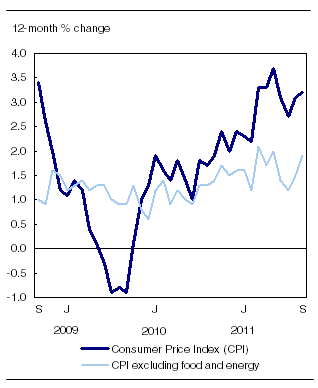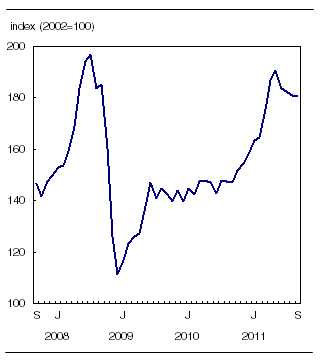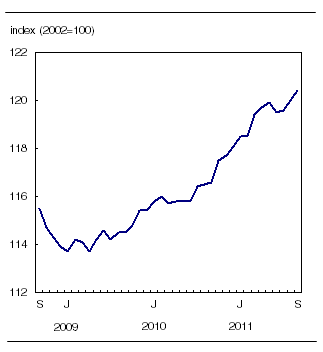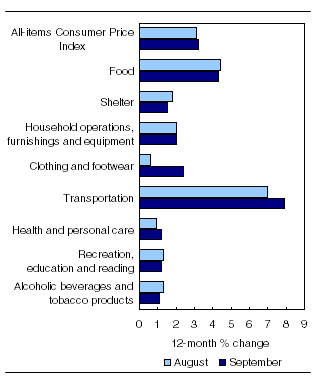Consumer Price Index
Archived Content
Information identified as archived is provided for reference, research or recordkeeping purposes. It is not subject to the Government of Canada Web Standards and has not been altered or updated since it was archived. Please "contact us" to request a format other than those available.
Related subjects
-
[an error occurred while processing this directive]
Consumer prices rose 3.2% in the 12 months to September, led by higher prices for gasoline and food. This follows a 3.1% increase posted in August.
The 12-month change in the CPI and the CPI excluding food and energy

Chart description: The 12-month change in the CPI and the CPI excluding food and energy
Energy prices advanced 12.5% during the 12 months to September, following a 13.4% increase in August. On a year-over-year basis, gasoline prices rose 22.7%, after gaining 22.8% in August. Prices for fuel oil rose 27.4% while prices for natural gas fell 4.7%.
Prices for food rose 4.3% in the 12 months to September after increasing 4.4% in August.
Excluding food and energy, the Consumer Price Index (CPI) increased 1.9% in the 12 months to September, following a 1.5% advance the month before. Larger year-over-year price increases in September were observed for the purchase of passenger vehicles, clothing and passenger vehicle insurance premiums.
Note to readers
The special aggregate "Energy" includes electricity; natural gas; fuel oil and other fuels; gasoline; and fuel, parts and supplies for recreational vehicles.
The Bank of Canada's core index excludes eight of the Consumer Price Index's most volatile components (fruit, fruit preparations and nuts; vegetables and vegetable preparations; mortgage interest cost; natural gas; fuel oil and other fuels; gasoline; inter-city transportation; and tobacco products and smokers' supplies) as well as the effects of changes in indirect taxes on the remaining components.
The gasoline price index since September 2007

Chart description: The gasoline price index since September 2007
Seasonally adjusted monthly CPI increases
On a seasonally adjusted monthly basis, consumer prices rose 0.3% from August to September, matching the increase recorded the month before. The transportation index advanced 1.0% after increasing 0.9% in August.
Seasonally adjusted monthly Consumer Price Index increases

Chart description: Seasonally adjusted monthly Consumer Price Index increases
The seasonally adjusted clothing and footwear index rose 1.0% in September, following a 0.1% decline in August. The food index went up 0.2% while the shelter index fell 0.4%.
12-month change: Prices rise in all major components
On a year-over-year basis, prices increased in all eight major components in September. Transportation and food continued to post the largest increases.
Transportation and food post largest gains

Chart description: Transportation and food post largest increases
The cost of transportation increased 7.9% in the 12 months to September, following a 7.0% gain in August. In addition to paying more for gasoline, consumers paid more in passenger vehicle insurance premiums. Prices for air transportation and the purchase of passenger vehicles also advanced.
Food prices rose 4.3% on a year-over-year basis in September. Prices for food purchased from stores rose 4.8%, following a 5.0% increase in August. Consumers paid more for meat (+6.1%), bakery products (+7.2%) and fresh vegetables (+13.0%). Prices for food purchased from restaurants went up 3.1%.
Shelter costs rose 1.5% in the 12 months to September, following a 1.8% gain in August. In addition to higher prices for fuel oil, consumers paid 5.7% more for homeowners' home and mortgage insurance. Conversely, mortgage interest cost, which measures the change in the interest portion of payments on outstanding mortgage debt, decreased 1.8% in September. Prices for natural gas also fell.
Prices for recreation, education and reading went up 1.2% after rising 1.3% in August. Tuition fees rose 4.2% year-over-year in September. This follows a 3.8% increase in September 2010. Prices for cablevision and satellite services also increased, while prices for video equipment fell.
Clothing and footwear prices increased for the fifth consecutive month, rising 2.4% in September. This followed a 0.6% gain in August. Prices for men's clothing rose 3.8% after increasing 1.8% in August.
Provinces: Gasoline still the main factor in all provinces
Consumer prices rose in every province in September. Higher prices for gasoline were the principal factor behind the increases in all provinces.
Nova Scotia and New Brunswick post largest price increases

Chart description: Nova Scotia and New Brunswick post largest price increases
In Ontario, consumer prices went up 3.4% in the 12 months to September, after rising 3.1% in August. Consumers in Ontario paid 24.2% more for gasoline. Passenger vehicle insurance premiums rose, while prices for electricity fell.
Prices in Quebec increased 3.4%, matching the gain in August. Gasoline prices rose 24.9%. Consumers paid 33.6% more for fuel oil. Prices for food purchased from restaurants, meat and the purchase of passenger vehicles also increased.
In Alberta, prices advanced 2.8% in the 12 months to September, after increasing 2.9% in August. Gasoline prices rose 20.0%, while prices for electricity increased 15.8%. Alberta consumers also paid more for homeowners' home and mortgage insurance.
Prices in British Columbia went up 2.4% in the 12 months to September, following a 2.1% increase in August. Gasoline prices rose 17.3%. Consumers paid more for homeowners' home and mortgage insurance and for food purchased from restaurants.
Nova Scotia and New Brunswick recorded the largest increases in consumer prices (+4.2%), led by higher prices for gasoline, food purchased from stores and fuel oil in both provinces.
Bank of Canada's core index
The Bank of Canada's core index advanced 2.2% in the 12 months to September, the largest year-over-year gain since December 2008. The increase follows a 1.9% rise in August. Larger year-over-year price increases in September were observed for the purchase of passenger vehicles, clothing and passenger vehicle insurance premiums.
The seasonally adjusted monthly core index increased 0.3% in September, after rising 0.4% in August.
For a more detailed analysis, consult the publication The Consumer Price Index.
Available on CANSIM: tables 326-0009, 326-0012, 326-0015 and 326-0020 to 326-0022.
Definitions, data sources and methods: survey number 2301.
More information about the concepts and use of the CPI are also available online in Your Guide to the Consumer Price Index (62-557-X, free) from the Key resource module of our website under Publications.
The September 2011 issue of The Consumer Price Index, Vol. 90, no. 9 (62-001-X, free), is now available from the Key resource module of our website under Publications. A more detailed analysis of the CPI is available in this publication.
The Consumer Price Index for October will be released on November 18.
For more information, or to enquire about the concepts, methods or data quality of this release, contact Statistics Canada's National Contact Centre (613-951-8116 or toll-free 1-800-263-1136; infostats@statcan.gc.ca), Communications Division.
- Date modified:
